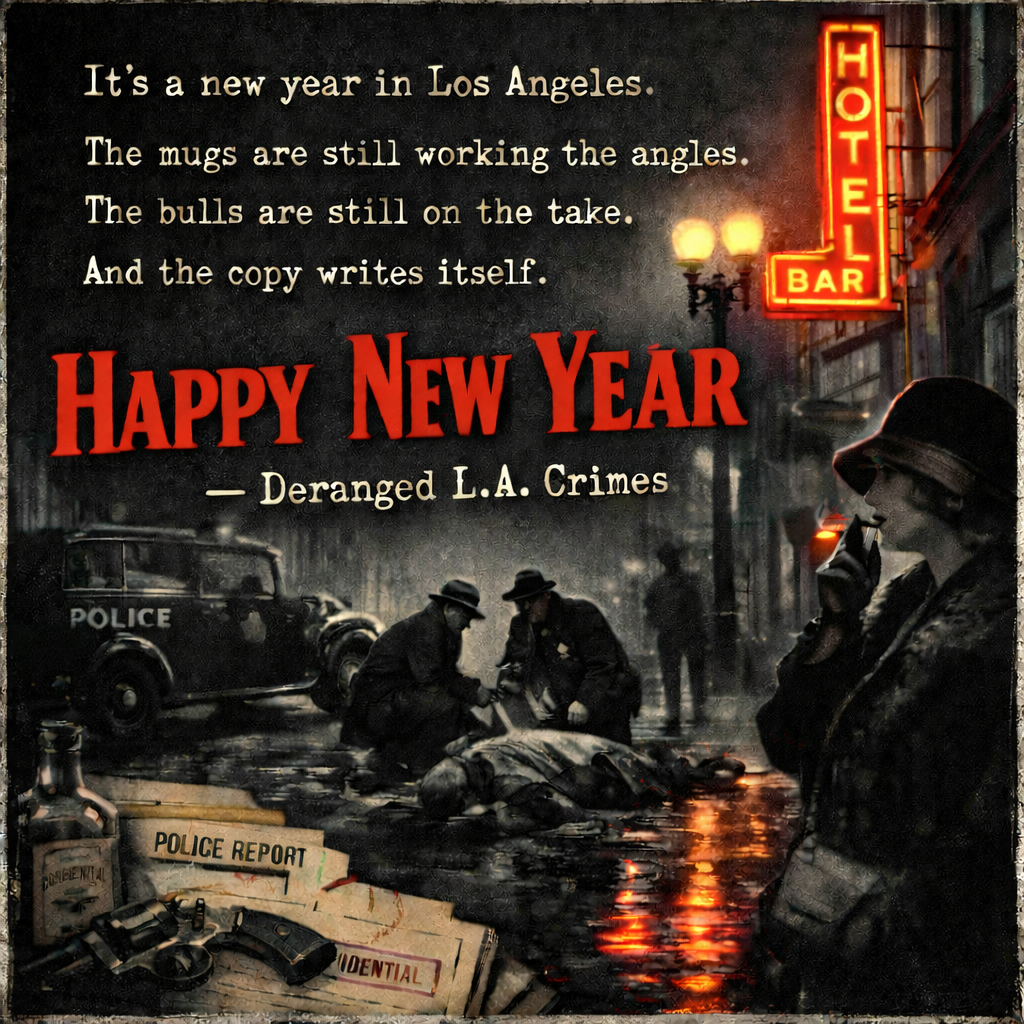
Happy New Year!



Welcome to Deranged L.A. Crimes. Ten years ago, I started this blog to cover historic Los Angeles crimes. I am not surprised that I haven’t even scratched the surface of murder and mayhem in the City of Angels.
I have been absent from the blog for a while, focusing on finishing my book on L.A. crimes during the Prohibition Era for University Press Kentucky. It’s not done yet, but I’m close. No matter, it is time to return to the blog. It is something I love to do.
Focusing my energy on the book, I failed to pay tribute to the inspiration for Deranged L.A. Crimes, Agness “Aggie” Underwood, on December 17, 2022, the 120th anniversary of her birth. If you aren’t familiar with Aggie, I’ve written about her many times in previous posts.
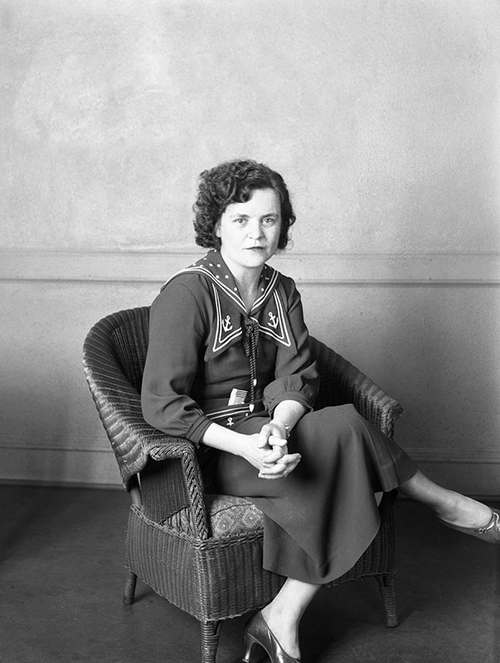
In 2016, I curated a photo exhibit at the Los Angeles Central Library downtown. The exhibit, for the non-profit Photo Friends, featured pictures from cases and events Aggie wrote about over the course of her career. I wrote a companion book, The First with the Latest!: Aggie Underwood, the Los Angeles Herald, and the Sordid Crimes of a City.
Aggie is a dame worth learning about. She is a legendary crime reporter, who worked in the business from 1927 until her retirement from the Los Angeles Herald in 1968. A force to be reckoned with, Aggie worked as a reporter until her promotion to City Editor of the Herald in January 1947, while covering the Black Dahlia case. She was the only Los Angeles reporter, male or female, to get a by-line for her reporting on the ongoing investigation.
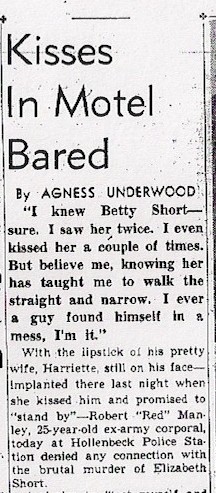
On her retirement, she told a colleague that she feared being forgotten. That won’t happen on my watch. Thanks again, Aggie, for the inspiration. Deranged L.A. Crimes is dedicated to you.
Among the things I’ve learned over the years researching and writing about crime, is that people don’t change. The motives for crime are timeless: greed, lust, anger, betrayal, and jealousy are but a few.
What is different is crime detection. Science has come a long way. Detectives no longer use the Bertillon system to identify criminals—they use DNA. I think part of the reason I’m drawn to historic crime is the challenges overcome by former detectives and scientists. Despite the advancements in science, it is my belief that if it was possible to pluck the best detectives and scientists from the past and set them down in the present, they would still be great. I am amazed at the cases they solved.
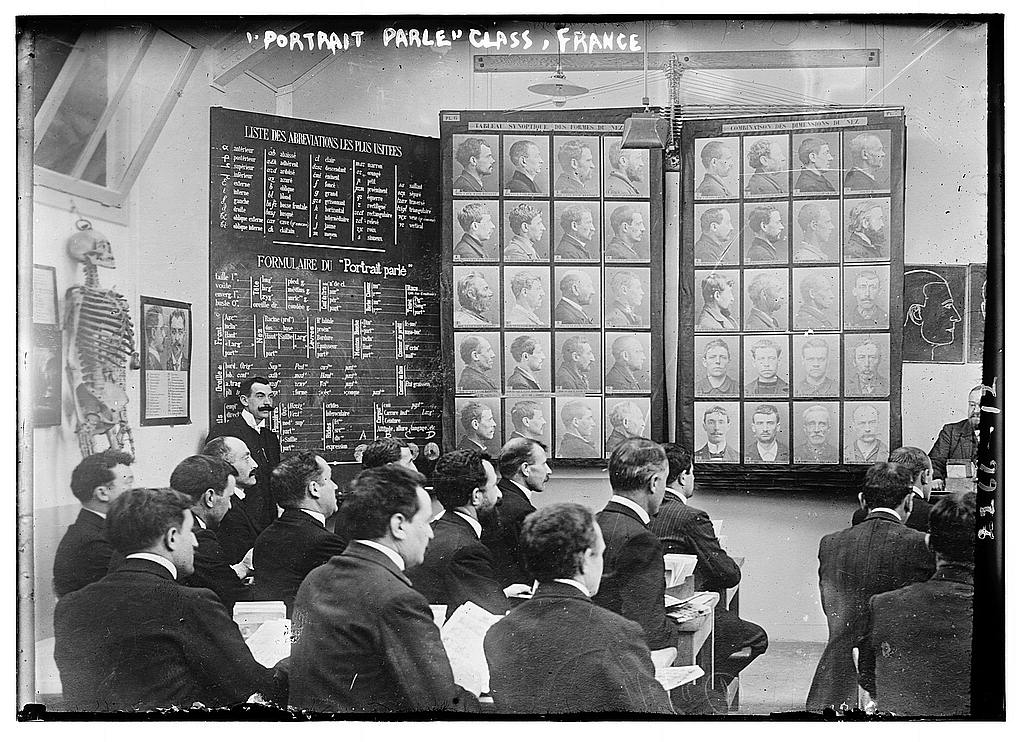
I look forward to this new year, and to the challenges it will bring. I am so glad you are here, and I invite you to reach out if you have questions and/or suggestions.
Best to all of you in the New Year.
Joan

Welcome! The lobby of the Deranged L.A. Crimes theater is open. Grab a bucket of popcorn, some Milk Duds and a Coke and find a seat.
I am following-up my tribute to the L.A. County Sheriff’s Department Homicide Bureau, aka the Bulldogs, with the 1995 film, HEAT. Why? Because one of the Bulldogs has a small role in the movie. Look for retired Sheriff’s homicide detective, Rey Verdugo, as Vegas cop.
Bulldogs. Is there nothing they can’t do?
IMDB says:
Master criminal Neil McCauley (Robert De Niro) is trying to control the rogue actions of one of his men, while also planning one last big heist before retiring. Meanwhile, Lieutenant Hanna (Al Pacino) attempts to track down McCauley as he deals with the chaos in his own life, including the infidelity of his wife (Diane Venora) and the mental health of his stepdaughter (Natalie Portman). McCauley and Hanna discover a mutual respect, even as they try to thwart each other’s plans.
Heat is based on the true story of Neil McCauley, a calculating criminal and ex-Alcatraz inmate who was tracked down by Detective Chuck Adamson in 1964.
Enjoy the movie!
Yesterday was the 117th anniversary of Aggie Underwood’s birth. In her honor the Central Library downtown is hosting a party on Saturday, December 21, 2019 at 2 pm.
I will speak about Aggie and her many accomplishments from her time as a switchboard operator at the Record to her groundbreaking promotion to city editor at the Evening Herald and Express. And yes, there will be cake.
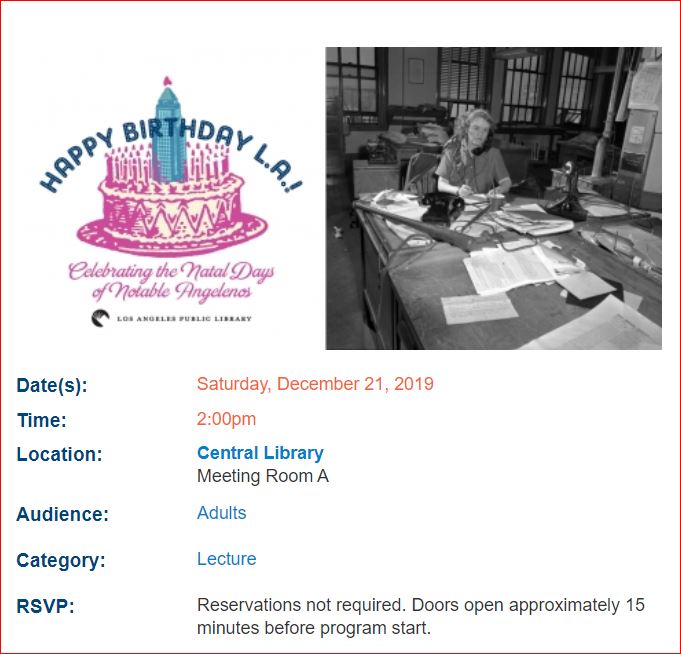
Aggie inspired me to create this blog and her Wikipedia page on December 12, 2012. Aggie loved the newspaper business as much as I love writing for the blog and connecting with all of you.
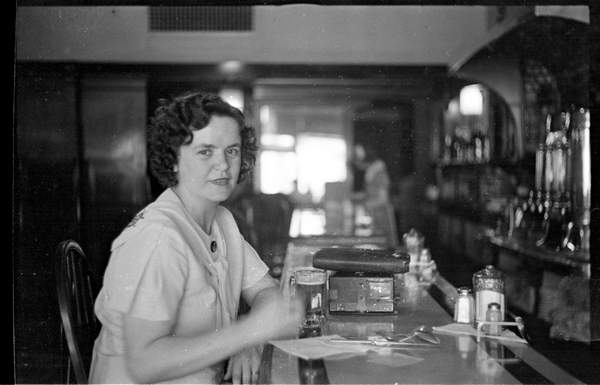
Deranged L.A. Crime readers are an impressive group. They include current and former law enforcement professionals, crime geeks (like me), and the victims of violent crime. I have even been contacted by a serial rapist (a despicable scumbag).
Each December I reflect on the year that is ending and make plans for Deranged L.A. Crimes. In 2020, the blog’s reach will extend to encompass all of Southern California, which includes the following counties: Los Angeles, San Diego, Orange, Riverside, San Bernardino, Kern, Ventura, Santa Barbara, San Luis Obispo, and Imperial.
I look forward to new stories, personalities and challenges.
Please join me as we enter the Roaring Twenties. This time, no Prohibition.
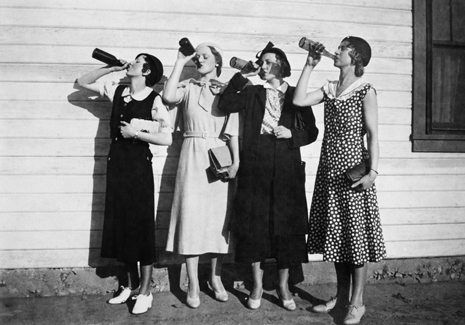

Aggie hoists a brew c. 1920s. [Photo courtesy LAPL]
Aggie Underwood was born on December 17, 1902 and Deranged L.A. Crimes was born on December 17, 2012, so there’s a lot to celebrate today. We have so many candles on our birthday cake it will take a gale force wind to blow them all out.
It was Aggie’s career as a Los Angeles journalist that inspired me to begin this blog; and my admiration for Aggie and her accomplishments has grown in the years since I first became aware of her.
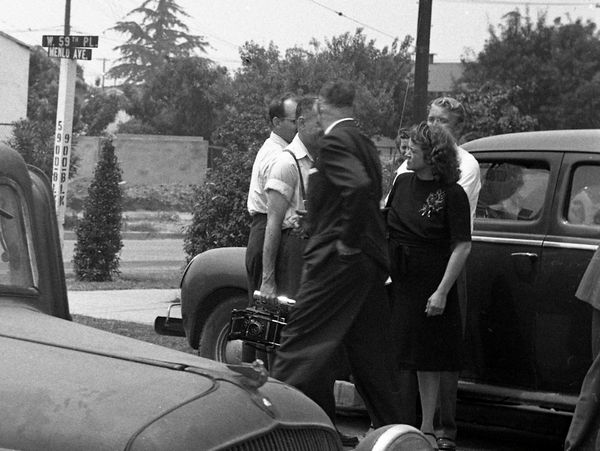
Aggie at a crime scene in 1946.
Aggie’s newspaper career began on a whim. In late 1926, she was tired of wearing her sister’s hand-me-down silk stockings and desperately want a pair of her own. When she asked her husband Harry for the money, he demurred. He said he was sorry, they simply couldn’t afford them. Aggie got huffy and said she’d buy them herself. It was an empty threat–until a close friend called out of the blue the day following the argument and asked Aggie if she would be interested in a temporary job at the Daily Record. Aggie never intended to work outside her home, but this was an opportunity she couldn’t pass up.
In her 1949 autobiography, Newspaperwoman, Aggie described her first impression of the Record’s newsroom as a “weird wonderland”. She was initially intimidated by the men in shirtsleeves shouting, cursing and banging away on typewriters, but it didn’t take long before intimidation became admiration. She fell in love with the newspaper business. At the end of her first year at her temporary job she realized that she wanted to be a reporter. From that moment on Aggie pursued her goal with passion and commitment.

Aggie at her desk after becoming City Editor at the Evening Herald & Express. Note the baseball bat — she used it to shoo away pesky Hollywood press agents. [Photo courtesy LAPL]
During a time when most female journalists were assigned to report on women’s club activities and fashion trends, Aggie covered the most important crime stories of the day. She attended actress Thelma Todd’s autopsy in December 1935 and was the only Los Angeles reporter to score a byline in the Black Dahlia case in January 1947. Aggie’s career may have started on a whim, but it lasted over 40 years.
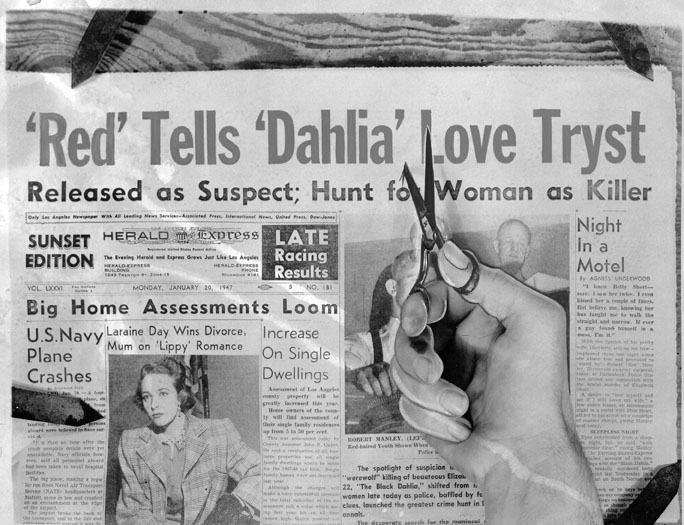
Look closely and you can see Aggie’s byline under “Night In a Motel”. [Photo courtesy LAPL]
Over the past nine years I’ve corresponded with many of you and I’ve been fortunate enough to meet some of you in person. Your support and encouragement mean a lot to me, and whether you are new to the blog or have been following Deranged L.A. Crimes from the beginning I want to thank you sincerely for your readership.
There will be many more stories in 2022, and a few appearances too. Look for me in shows on the Investigation Discovery Network (I’ve been interviewed for Deadly Women, Deadly Affairs, Evil Twins, Evil Kin and many others.) I am currently appearing in the series CITY OF ANGELS: CITY OF DEATH on HULU.
Kentucky University Press will publish my compilation of tales on L.A. crime during Prohibition. Title is TBA.
You can find my short story in the recently released anthology, PARTNERS IN CRIME, edited by Mitzi Szereto.
Whether it is on television, in the blog or some other medium I’m looking forward to telling more crime tales in 2022.
Happy Holidays and stay safe!
Joan
One thing the trial of the Spitzer twins made clear, they were like two perverted peas in a pod. Aside from the horror of the rapes they committed, the litany of creepy behaviors in which the twins engaged are appalling.
The prosecutor sought to demonstrate that the twins “executed a common design or plan to have sex with the same woman.” Part of the prosecution’s case was to show videotapes, not only of the rapes, but of the twins mugging for the camera and referring to themselves as “The World’s Swingingest Lovers.” They failed, at every opportunity, to comprehend that they were not lovers of women, they were rapists.
In one of the most disturbing tapes the twins are naked, and aroused, in each other’s presence. The defense attorney attempted to sell the notion that the 40-year olds were acting “…like 12-year old boys in a locker room.” The prosecutor refuted that characterization and suggested that “these are 40-year old men turning each other on, and the only thing [that is] lacking in this film is the woman to actually penetrate while they are having this sexually provocative act.”
The jurors were also treated to scenes from the twins’ porno movie, “Kisses From Romania—its one and only public showing. The jury gave it twelve thumbs down. The movie is shot documentary style and consists of a series of scenes in which “Julian” a rich American film producer, is in Bucharest looking for the most beautiful Romanian woman to make a movie. Julian manages to entice several women and the scene cuts to a dirty sofa bed where Julian quizzes the women about their sexual fantasies. One woman says that she has fantasized about lesbian sex. Another says she enjoys romantic sex and wants to do it in a boat. Another says she has tried anal sex. Each woman, after a bribe, is invited to undress slowly. There is a lukewarm sex scene that has nothing to do with the previously mentioned fantasies.
The film was reviewed by a Romanian porn aficionado. He said that the women were not erotic, although they conveyed “hunger and poverty.” If you’re curious, here is an edited clip from the film in which there is no nudity.
Another of the tapes showed Stefan sodomizing a woman with a foreign object, attempting oral copulation, and committing rape. Stefan said the women on those tapes were not drugged and that he and George had only made the videotape for their own “private amusement.”
The twins admitted that some of the videos were made without consent, but claimed that they only engaged in consensual sex. “They were all having a good time,” Stefan said.
The twins seemed confident that the rape charges would not be proved. Date-rape cases are difficult to prosecute. The great majority of date rapes go unreported. There is often scant physical evidence to work with. Unless the woman goes immediately to a hospital, she may not be able to demonstrate that a rape took place. In such cases it is nearly always a struggle getting victims to come forward—they are often confused and ashamed.
In the case against the Spitzers, twelve women came forward to testify. They had not consented to sex and they certainly had not been having a good time. George and Stefan’s victims came from all walks of life. Among those who came forward was a flight attendant, a college student, a woman who worked in a mall and a lawyer. The 16 known victims were probably just the tip of the iceberg. There is no way to know the number of Spitzer victims who never came forward.
The twins’ 79-year old father testified on their behalf, but it wasn’t enough. Neither was the defense case which sought to portray the twins in a “boys will be boys” light. The jury could see that the defendants hadn’t been engaged in youthful hi-jinx, they were grown men and they were rapists.
The jury deliberated for little more than a day. As the jurors filed into the courtroom to deliver the verdict, five of the Spitzer twins’ victims sat in the front row and held hands. The jury found George and Stefan guilty.
Before sentencing, the twins addressed the judge, saying that none of the videotapes showed a woman being drugged and that none of the so-called victims had produced a positive drug test.
The Judge didn’t care. He saw no signs of compassion or remorse, and women simply were not safe when the Spitzer twins were free. George was sentenced to 60 years in prison and Stefan to 37 years. Their sentences were later reduced on appeal.
As they were being sentenced, the twins shook their heads in sync with one another. Then Stefan looked at George, but George didn’t look back.
Prosecutor Mary Hanlon Stone warned women: “Never let a stranger buy you a drink.”
And here’s a rule of thumb: If you suspect you’ve been drugged and/or a victim of date-rape, pee in a cup right away.
AFTERWORD
I said at the beginning of this series of posts I discovered that the twins had been released from prison. I couldn’t find them in the California Sex Offender Registry—they seemed to have vanished. Of course they hadn’t vanished at all—because they were citizens of Canada they were returned there after serving their sentences.
In August 2014 the citizens of Outremont, a borough outside Montreal proper, were alarmed to discover that for five years a man with a violent criminal past was living in their midst. The man was fifty-eight year-old George Spitzer. He had been living in the area since his expulsion from the U.S. in 2009. By Canadian law, authorities should have imposed a peace bond, an “810” order on George. The 810 is made when, according to legal analyst Philip Schneider, “…you have reasonable grounds to believe there is a potential danger to the public.” Stefan Spitzer was living with conditions imposed on him—why not George? It seemed that the reason for the snafu was down to an administrative error between the U.S. and Canadian officials.
Anyone familiar with the Spitzer’s history won’t be shocked to learn that George was arrested in 2013 for defrauding a Montreal woman of $100,000. At least he wasn’t raping anyone.
Stefan was arrested by Montreal Police, shortly after George, for breaching an unspecified condition of his release.
I have tried to find current news regarding the Spitzer twins but so far have been unsuccessful. If there are any Canadian readers who know the status of the twins please, please let me know.
Media coverage on date rape drugs was sparse in the early 1990s. There was one high profile story involving Rophynol in March 1994; and that was the near fatal overdose of Nirvana front man Kurt Cobain. He had combined roofies and champagne in what appeared to have been an accidental O.D. Tragically Cobain was found dead, apparently by his own hand, a month later.
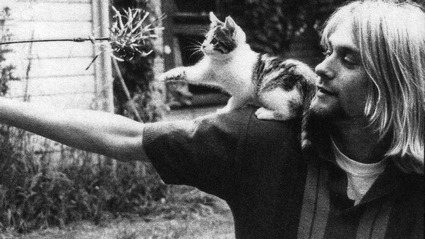
Kurt Cobain
News coverage on roofies continued sporadically until 1996 when it exploded. The potential for the drug to be used in date rape was a hot topic for women’s magazines and magazines geared toward teenage girls. Oprah Winfrey was one of many TV talk show hosts who covered the dangers of date rape drugs. Discussion of the the drugs wasn’t confined to talk shows; scripted shows like Beverly Hills 90210 and South Park also weighed in. Women were warned never to leave a drink unattended and to avoid punch bowls at parties.
It may have been the heightened awareness of the existence of date rape drugs that brought the law to the Spitzer’s front door in mid-1996.
On July 9, 1996, 36-year-old flight attendant Kimberly B had a few days off between flights. She was with friends at a sidewalk café in Marina del Rey when she met Stefan and George Spitzer.
George, who introduced himself as Gino, struck up a conversation with Kimberly in the parking lot of the café. He asked her if she was interested in having an authentic Italian dinner with an authentic Italian. Kimberly was intrigued because she was planning a trip to Italy. Maybe the guy could offer insider tips on where to stay and what to see. They exchanged phone numbers.
Kimberly heard from George later that day and they arranged to meet at a local Starbuck’s at 8:00 p.m. The couple went to Jake and Annie’s restaurant where George ordered a bottle of wine and proceeded to regale his date with increasingly unbelievable tales—like how the movie “The Godfather” was based on his dad. Then he told her he had a Ph.D. in psychology and, among his other amazing accomplishments, he was Raquel Welch’s personal trainer.
 Kimberly easily saw through George’s lies, and it didn’t take long before she had had enough. She knew that there would not be a second date and took immediate steps to put the excruciating evening to an end. She told George she had to be home by 11:00 p.m. to relieve the babysitter who was watching her 6-year-old daughter. And then she watched the clock.
Kimberly easily saw through George’s lies, and it didn’t take long before she had had enough. She knew that there would not be a second date and took immediate steps to put the excruciating evening to an end. She told George she had to be home by 11:00 p.m. to relieve the babysitter who was watching her 6-year-old daughter. And then she watched the clock.
The kitchen at Jake and Annie’s restaurant was closing so the pair went a couple of blocks over to the World Café where they had dinner and wine. Kimberly had one glass. Following dinner Kimberly reminded George that she had to be home by 11. At 10:00 she excused herself to go to the ladies’ room. She was waiting in line when George came up to her and asked her how long she would be—she was away for about 10 minutes before returning to the table. She was relieved that her date with the tedious blowhard would soon be over. With any luck at all she would be home by 10:30.
Kimberly awakened at 5:45 a.m. the next morning and couldn’t get her bearings. The room was spinning. She tried to shake the cobwebs out of her head. She looked around expecting to be in her own bedroom, but she was naked and in bed with George. What the hell had happened? She remembered nothing after the restaurant. Dazed and moving in slow motion Kimberly quietly dressed and left the apartment. It was a miracle she made it home without incident.
She ran into George later that day and asked him point blank if they’d had sex. He denied it. She didn’t believe him.
Kimberly went to the Los Angeles County Sheriff’s Marina del Rey substation. She told deputies that she was certain that a creep who called himself Gino Sorrelle had slipped Rohypnol into her wine glass during dinner the previous night and she wanted to file a complaint. She was taken to a nearby hospital for a rape kit. Semen was found in Kimberly’s vagina and rectum.
Sheriff’s investigators secured a warrant to search the Spitzer’s apartment and they uncovered over 20 videotapes. The tapes showed 12 different women, who appeared to be under the influence, being raped. The rapist wasn’t immediately identified. Dealing with identical twins presents law enforcement with unique problems. The investigators also found 20 boxes of Rohypnol. Is there any legitimate reason for private citizens to have that much Rophynol on hand?
George was arrested on August 7, 1996 and Stefan was arrested a few weeks later. Each of them was held on $2 million bail.
The circus was about to begin.
NEXT TIME: Would the twins finally be held accountable?
In 2013 I appeared in an episode of Investigation Discovery Channel’s show EVIL TWINS to discuss George and Stefan Spitzer. The brothers were tried and convicted of sexual assault in the late 1990s.
Prior to my appearance the producers provided me with research on the case. The notes were thorough but, even so, I wanted to dig into the case on my own. It’s something I always do when I’m going to be interviewed for a crime show. Maybe the production company researchers had missed something, or I’d discover a detail that would add to my overall understanding of the case.
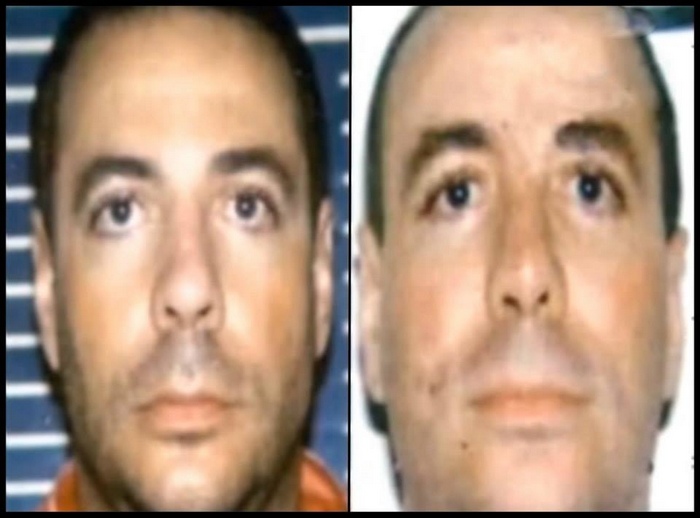
The first thing I wanted to know was if the Spitzers were still in prison so I searched the State of California Inmate Locator. I was shocked to discover that George Spitzer had been released in 2009. He was considered a high risk offender and the only record I found stated “The registrant may have subsequently relocated.” Then I searched the California Sex Offender Registry. He wasn’t there. George was in the wind. With his history I was convinced that he presented a threat to women.
Over the past four years I’ve thought about the Spitzer twins and the hell they put several women through. I searched off and on but couldn’t find any information regarding George’s whereabouts; until today.
Before we get to the Spitzer twins in the 2010s, let’s look into their past.

George and Stefan Spitzer (aka Gino and Julian, respectively) were born in 1956, in Bucharest, Romania, the sons of holocaust survivors. During World War II, the Spitzer parents hid from the Nazis in Bucharest. The twins’ grandparents died in Nazi gas chambers.
The twins lived in Bucharest behind the Iron Curtain until the early 1970s when they fled to Israel and Greece. In 1975, their mother died of cancer. After her death, their father moved the family to Toronto, Canada where he worked as an accountant.
As children the twins were like one person; nothing separated them. As they got older their distinctive personalities began to develop. George was more aggressive and usually called the shots. Stefan wasn’t as sharp as his brother. He was immature and had impulse control problems.
Even though Stefan was a dim bulb the girls liked him better. George was competitive and jealous of Stefan’s status as a chick-magnet.
The twins came to Los Angeles on vacation. They fell in love with the glamour of the big city—Palm trees, swimming pools, beautiful women. By the early 1980s they’d moved to Hollywood to become actors. They networked, auditioned and took jobs driving scenery around. They were attractive enough, but they couldn’t act. They had portfolios made and tried modeling but that didn’t work out either.
George and Stefan got a minor show business break when Liberace hired them as valets. The twins would later say that they were fired when they spurned the flamboyant showman’s sexual advances. I’m inclined to disbelieve anything the Spitzers have ever said.
After the acting gigs didn’t materialize and Liberace let them go, the brothers decided to switch gears and become film producers. They attempted to raise money for a porn project but earned a reputation as being quick to anger, and out of touch with reality. When they did get a nibble from a potential backer they always blew it with their irresponsible behavior.
They actually made a porn film—but it stayed under everyone’s radar. The bottom line was that George and Stefan were show business failures.
The switched gears again. They became car salesmen.
George and Stefan lived in a series of small apartments, first on the edge of Beverly Hills, then in West Hollywood, then in Marina del Rey, not far from the waterfront. They saw lots of beautiful women, but felt that the prettiest of them exceeded their grasp—unless they pretended to be something they weren’t—accomplished and successful.
They used pseudonyms when they tried to pick up women. George introduced himself to potential dates as Gino, supposedly the son of a Mafia godfather. Stefan called himself Julian, a martial artist who’d trained film star Jean-Claude Van Dam. To add international flair to their pick-up attempts they feigned Italian or French nationality and they creatively represented themselves as movie producers, pilots and psychologists
George and Stefan enjoyed using their nearly identical looks to fool women. They would change places in the middle of sex. They called it the “Spitzer switch.” But even though the twins shared the same facial features, and precisely the same chain of chromosomes in their DNA, careful observers could tell them apart—especially with their clothes off. Stefan was an inch shorter and 15 pounds heavier than George and had more body hair.
From the moment the twins arrived in California they had lied and deceived most of the women they met. Sure, their behavior was smarmy but they exhibited more ominous character flaws than self-aggrandizement. There were signs that George and Stefan were not the sort of guys who would accept no for an answer from any woman
NEXT TIME: The Spitzer twins cross a line.
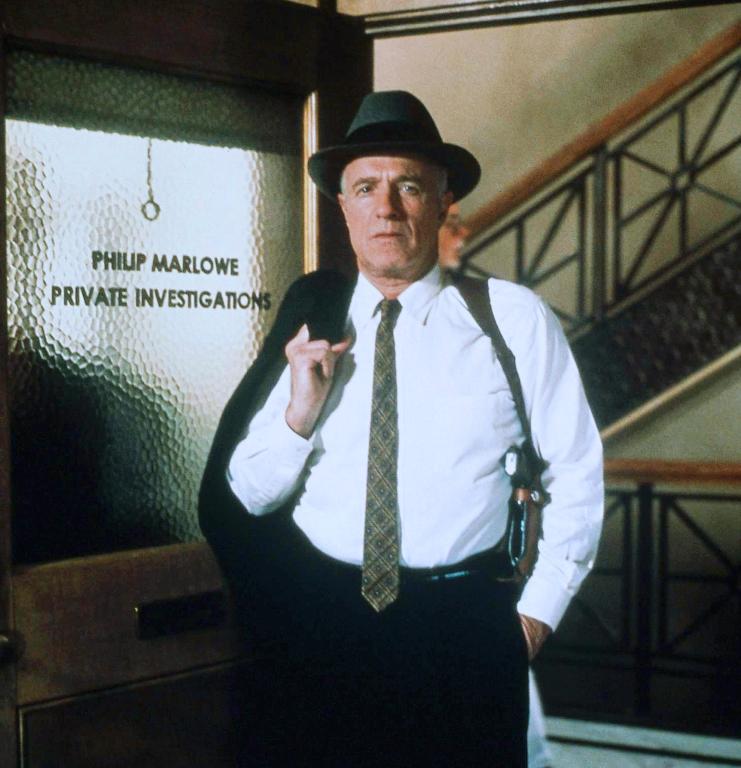
Welcome! The lobby of the Deranged L.A. Crimes theater is open. Grab a bucket of popcorn, some Milk Duds and a Coke and find a seat. Tonight’s feature is POODLE SPRINGS starring James Caan and Dina Meyer.
Enjoy the movie!
TCM says:
Television movie based on the novel by Robert Parker, from the final Philip Marlowe story begun by Raymond Chandler. Hard-boiled detective Philip Marlowe is 15 years past his prime, as cynical as ever, but also a newlywed. Moving to the small desert town of Poodle Springs after marrying Laura, the daughter of billionaire P.J. Parker, Marlowe becomes immersed in deadly intrigue surrounding the murder of another investigator. When he uncovers a scheme to move the state border of Nevada, which may involve his father-in-law, the world-weary private eye from the 1940s encounters a ’60s web of greed, lust and murder. With a talent for attracting trouble, Marlowe finds it in the form of murder, bigamy, gambling, pornography and double identity.
https://youtu.be/5bHuS2v4LA8
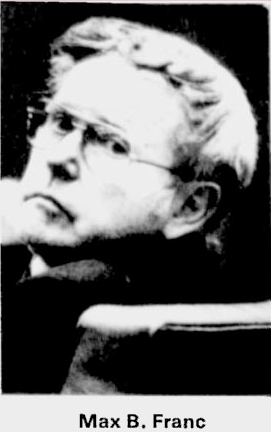
Tracy Leroy Nute, alleged teenage victim of Professor Max Bernard Franc’s “homosexual rage”, was described by his mother, Judy Nute, as a “sentimental” and “naive” kid with problems. Interviewed in her Kansas home she said that her son had been in trouble with the law, “but nothing that any rowdy teenager wouldn’t have gotten into.”
Tracy’s scrapes with the law may have been minor, but at some point Judy found it impossible to handle him and he spent much of his time in juvenile homes. The homes in which he was placed didn’t work out and he decided, like many unhappy kids, to head for Southern California. His destination was Hollywood where he intended to become an actor. Runaways have been coming to Hollywood in droves with the same dream since the first studios appeared in the 1910s. But big dreams die hard and fast when the reality of street life sets in–everything is a struggle–food, cigarettes, a place to crash. Tracy, like other teenage transplants before him, was most likely welcomed to town by drug dealers and pimps, not an agent with a movie contract. Tracy’s home state’s motto is Ad Astra per Aspera (To the Stars through Difficulties). He never reached a star, he never had the chance. By the spring of 1987 he was turning tricks, and by summer he was dead.
Max contended that he wasn’t Tracy’s killer and that the murder had been committed by a gay prostitute by the name of Terry Adams. According to Max, Terry had even lived with him for a while in Fresno. Did Terry exist? Sheriff’s investigators never found him; and Max was so terrified of being outed that he’d gone to great lengths to conduct a secret life in Hollywood. Would he have risked everything to bring a lover to Fresno? It is doubtful.
The trial was as interesting as had been anticipated. Rumors circulated that Tracy had attempted to extort money from Max. If true the kid had morphed quickly from a naive Kansas runaway to a street-wise Hollywood blackmailer.
Public Defender, Mark Kaiserman, admitted that Max was a voyeur who suffered from poor judgment. Explicit photos of the victim were found among the hundreds discovered in Max’s apartment. Interestingly, no photos of his alleged lover were found. The attorney unveiled a unique defense which was based primarily on Max’s ineptitude. Kaiserman argued that Max was too “nerdy” and too much of “a klutz” to wield handle a gun, let alone manage a chain saw. Kaiserman reminded jurors that Max had cemented over the entire yard at his Fresno home to avoid using a lawn mower.
![]()
Was it a creative defense? Without a doubt. Was it an effective defense? Unfortunately for Max, no. He was found guilty of Tracy’s murder. Fear of exposure, if that was the motive for the slaying, easily explained how Max was able to overcome his nerdiness and commit such an atrocious murder.
The jury accepted the prosecution’s case that characterized the defendant as a man overcome by homosexual rage and rejected the defense argument that Max was too wimpy to have committed the crime. 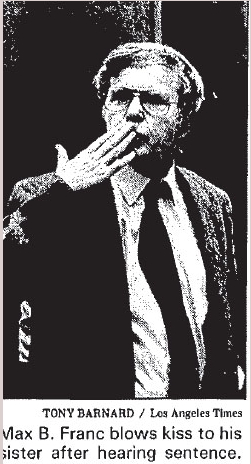
At his sentencing hearing Max’s sister, Carol Waiters, a psychiatric social worker from Philadelphia, made a plea for leniency on her brother’s behalf. She implored Judge John H. Reid to consider “the whole person” rather than the part of his personality that drove him to murder. On July 28, 1988, Judge Reid sentenced Max to from 25 years to life with the possibility of parole in 17 years.
Max didn’t live long enough to become eligible for parole. He died of a heart attack in Cochran State Prison on September 18, 1997.